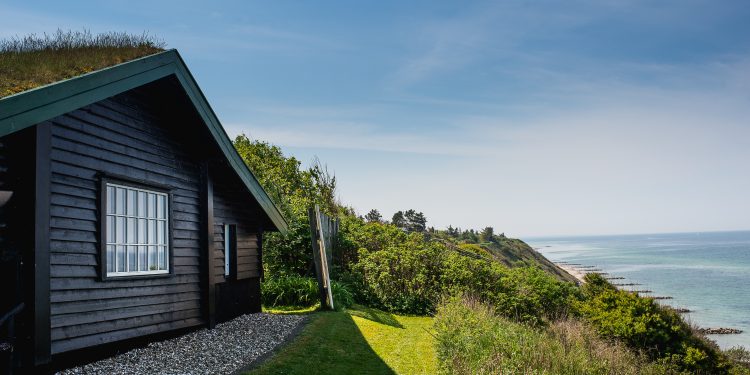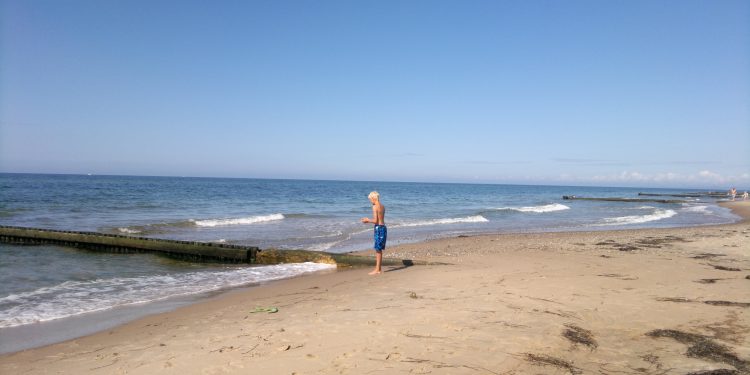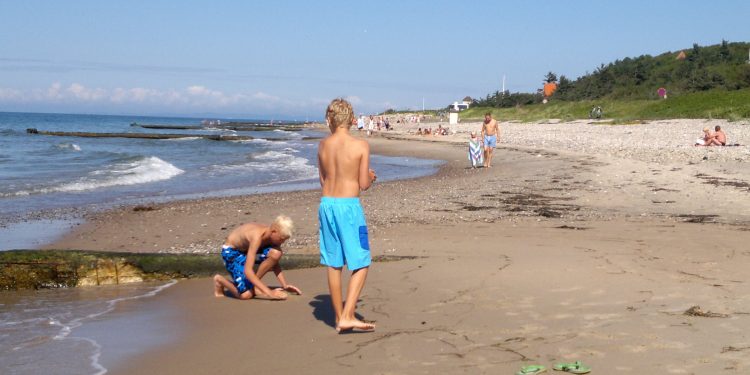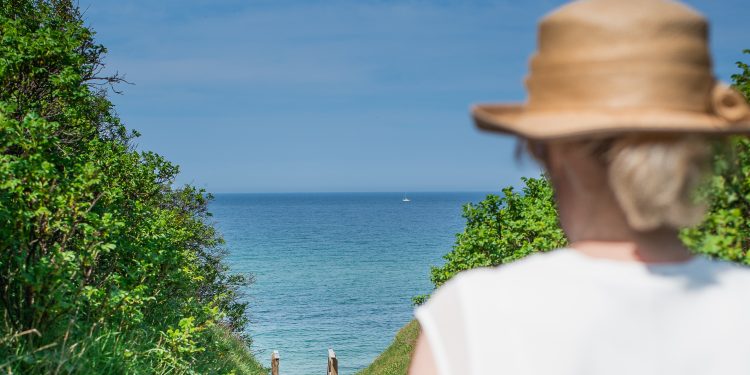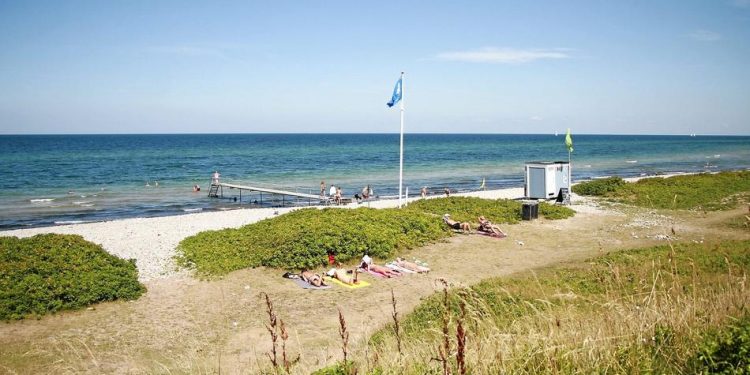Summer in Denmark with great beaches and top water quality
A Danish summer day can be really beautiful, and with an early sunrise and late sunset, a summer day seems endlessly long. Find inspiration in our guide here.
The article continues below.
By Bente D. Knudsen Pictures: Mayra Navarrete, Nordsjællands Kystlivreddertjeneste
I remember, before having children, how, when the weather was nice, we would grab hot dogs and cold beer and drive north of Copenhagen after work.
Here we would sit on the beach until the sun set, have a late evening swim, a barbecue on the beach, and drive back in the twilight with a dark city sky ahead and the last twinkle of sun-rays still visible in the sky behind us.
Danish summers are unpredictable; honestly, they are.
You have to be prepared for both warm, wonderful days and much cooler, rainier ones.
That’s the luck of an expat, compared to tourists: you do have the chance to experience and enjoy the good part.
And you have to be prepared to do just that. Change your plans and go to the beach when the weather permits.
And get over the coldness of the sea; you just have to get in.
As soon as your body is immersed, count to 10 (maybe longer), and experience how the body adjusts to the water’s max 20 degrees Celsius (actually, a good temperature here).
Not going in will make you miss out on the essence of a Danish summer; the clean, soft and silky texture of sea water surrounds your body, feeling much less salty, or so it seems, compared to warmer seas, with your skin shrinking, and filling with goose pimples, to protect it from the cold shock.
Many beaches have lifeguards present during the main season from 28 June and until the weekend after the school holiday ends in August( around the 17 August).
The article continues below.
Danish bathing water is of top quality
The EU Commission publishes a yearly bathing report with focus on water quality, bacteria and health risks for beaches and lakes in all 27 EU countries.
Its aim is to improve the water quality for bathers in general in the member countries.
The latest Danish figures reported that of the 1026 beaches monitored (and part of the report to the EU), the EU concluded that 90,7 percent had the highest-quality rating of excellent and a total of 98,3 percent had a satisfactory water quality.
The article continues below.
Find the secret beaches
You have public and secret beaches in Denmark, but even the secret ones are public.
More interesting, of course, is to find the secret ones; the ones hidden away from the general public and where only those living in the area really know them.
The challenge, apart from their secrecy, is accessibility both concerning public transport but even more so with parking.
The secret beaches are often located in summerhouse compounds, where, for safety reasons, parking is limited.
Another disadvantage of secret beaches is that some may lack toilet facilities, or you have to walk some distance to find them.
The best suggestion for finding a secret beach is to ask any Dane with a summerhouse where they go, get them to point it out on a map and consider driving there on a sunny day.
The article continues below.
Lifeguards on your beach
With more than 1,300 beaches, it is not possible to have them all equipped with lifeguards.
Only 58 beaches, the ones with the most guests and the best facilities, have lifeguards present during the main summer months and even then they are mostly present during the school summer holiday ( weeks 27 to 33) daily from 10:00 to 18:00. A few beaches start off already on 7 June with presence during the weekends as is the case at six beaches on the North Zealand Coastline.
Denmark has three different services guarding the beaches.
1)Nordsjællands Kystlivreddertjeneste (North Zealand Life Guard Service) guards 24 beaches during the school summer holidays on the North Zealand coast.
2)In Copenhagen City at two beach locations you will find Team Bade.
3)The Copenhagen Harbour baths, a total of 4 harbour baths are part of the 36 beaches all over Denmark where you can find the yellow and red towers from the Tryg Foundation’s lifeguard organisation TrygFonden Surf Lifesaving. The Harbour baths are open with life guards present from 1 June unti 31 Augus.
DO NOT bathe from anywhere else along the Copenhagen Harbour, it is NOT permitted (even if you see people doing this). Find the list of harbour baths here.
All beaches are free to use, but parking may not be. Find a complete list further down in the article.
The article continues below.
Beaches in the Copenhagen area
Going to the beach in Copenhagen? Take your bike!
On a hot summer day, Copenhageners will be on the move to the beach.
I recommend the three different harbour baths only if you don’t have small children. Small children will miss out playing in the sand and running along the beach in the water – but of course it is feasible to take them.
Swimming in the middle of Copenhagen harbour is a special feeling. The water is clean and safe, and there is a great five metre high diving board.
On the island of Amager, the beach at Amager Strand Park has been extended and renovated, and has lots of facilities, and if you can live with the building of new apartments in the background, then Svanemøllen Strand is also a good and easily accessible option.
Otherwise, head north towards Charlottenlund Fort, Bellevue in Klampenborg, or the smaller beaches in Taarbæk and Vedbæk, or you could also go south towards the beaches of Køge Bugt, where around Karlslunde there are lovely beaches as well.
If you want to find larger beaches, with long stretches of sand and where, if you walk a little, you can have it more to yourself, I recommend heading to the North Zealand coastline.
Particularly, Hornbæk Beach and Tisvildeleje Beach are great for a day trip. They can be reached by car or train.
Calculate about 50 minutes by car and 1.5 hours by train. You have to go via Hillerød with the S-train and change there.
They all have parking facilities (go early though) and when you feel like ice cream or a restaurant, their small villages have ice cream parlours, coffee houses, and restaurants that are open during the school holidays.
If you go at other times than the school holiday weeks they will be much less crowded, but also seem more “dead”, apart from sunny weekends.
A small tip from John Heine Mogensen, head of Nordkystens Livreddertjeneste; when lifeguards are present on the beaches they will update the weather reports regularly on the website.
“As the winds can be very different from the North Zealand coastline, compared to the Øresund coastline, a cloudy day in Copenhagen, might be a beautiful sunny one on the North Zealand coastline, so I can only recommend checking the weather of the beach you want to go to. It could still be worthwhile, even if, when looking out your own window, it does not seem to be a good day for a beach excursion.”
You can find the weather at the beaches on the North Zealand coastline here.
Vesterhavet versus the interior waters: Kattegat, Storebælt, Østersøen and Øresund
Vesterhavet is the Danish name for the North Sea coastline. Here the sea is much rougher and more dangerous than the calmer interior waters surrounding the rest of Denmark.
If you are going to Vesterhavet, the police actually recommend to head for a beach with a lifeguard present. The undercurrents are particularly strong and take swimmers by surprise.
The interior waters are much calmer, but of course always be wary of strong winds and rough seas.
The article continues below.
Find a complete list of all the beaches with lifeguards present below
Nordsjællands Kystlivreddertjeneste – all beaches on the North Zealand Coastline with lifeguards.
During the school holiday from week 27 to 32 you should be able to check for daily weather forecasts on their website www.livredningstjenesten.dk.
Hundested
Gråstenvej
Liseleje V
Liseleje Ø
Lille Kulgab
Stængehus
Tisvildeleje V
Tisvildeleje Ø
Strandbjerggård
Rågeleje
Smidstrup
Gilleleje
Strandbakkerne
Dronningmølle
Villingebæk
Hornbæk V
Hornbæk Ø
Langebro
Grønnehave
Snekkersten
Espergærde
Furesøbad (The large north lake of Copenhagen next to Holte/Farum)
Team Bade – Copenhagen City beaches with lifeguards. Information Facebook/ Team Bade
Amager Strand
Svanemøllen Strand
TrygFonden’s beaches with lifeguards can be found in different parts of Denmark
You can also find them on a map – go to the website here.
Zealand and Lolland
Sluseholmen Havnebad (Copenhagen)
Fisketorvet Havnebad (Copenhagen)
Islands Brygge Havnebad (Copenhagen)
Charlottenlund Strandpark (Copenhagen area )
Bellevue Strandpark (Copenhagen area)
Furesøbad (The large north of Copenhagen next to Holte/Farum)
Marielyst Strand
Enø Strand
Feddet Strand
Hundige Strand
Ishøj Strand
Vallensbæk Strand
Brøndby Strand
Rørvig Strand ved Kabelhuset
Gudmindrup Strand
Høve Strand
Jutland
Skagen Sønderstrand
Tornby Strand
Palmestranden Frederikshavn
Løkken Strand
Blokhus Strand
Grenaa Sydstrand
Den Permanente Badeanstalt
Moesgaard Strand
Saksild Strand
Fredericia Østerstrand
Søndervig Strand
Hvide Sande Sydstrand
Henne Strand
Vejers Strand
Rindby Strand
Lakolk Strand
Funen
Kerteminde Nordstrand
Nyborg Strand
Bornholm
Balka Strand
Antoinette Strand
Support our magazine with a contribution of any size
We do not want to put up a pay-wall, so we need your support and if you find our content relevant and worthwhile, we would value any contribution, however big or small, as a token of your appreciation of our efforts.
How to support:
Transfer any contribution to our bank account at: Your Danish Life/ Danish Expat Media Aps
Danske Bank Account number: 3409 11405673
IBAN: DK68 3000 0011 4056 73
or MobilePay to 2144 1224
Message: Support
The article continues below.
Ever heard of a Blue Flag beach?
Denmark is one of 46 countries participating in the international eco-label programme with the most Blue Flag beaches; in 2025, a total of 143 Danish beaches will have the blue flag flying.
In Denmark, Friluftsrådet, the Danish Outdoor Council, runs the Blue Flag Programme.
On the website, blaaflag.dk, a nice map has them all listed, also in English. According to the Danish Outdoor Council there is a lot of prestige (and tourism) in the Blue Flag eco-label, and Danish municipalities put a great deal of focus on having them.
Apart from water quality, they also focus on availability of parking and toilet facilities, lifesaving and first aid equipment, the availability of an emergency phone close to the beach. Some of them have lifeguards present on the beach (during school holiday weeks).
Blue Flag Centre
Another nice option with children during the summer is to participate in the many fun and exciting activities at a Blue Flag Centre and learn more about the sea and coastal environment.
There are 14 Blue Flag Centres in Denmark, run in cooperation between the local municipalities and the Blue Flag organisation.
They are usually located in a harbour area and not on the beach.
Havnsø Havn, Kalundborg Municipality
Vandmanden – Rørvig, Odsherred Municipality
Tunen – Odden Havn, Odsherred Municipality
Sidesporet, Holbæk Municipality
Værkstedsvognen, Faaborg Municipality
Fjord & Bælt Centret, Kerteminde Municipality
Blå Flag Center Sønderborg, Sønderborg Municipality
Fiskeriets Hus, Ringkøbing-Skjern Municipality
Fjellerup Naturcenter, Norddjurs Municipality
Grenaa Naturskole, Norddjurs Municipality
Blå Flag Center Landkrabben – Ballen havn, Samsø Municipality
Det rullende Blå Flag center, Slagelse Municipality
Fjordhuset, Karrebæksminde, Næstved Municipality
Northsealiving, Thyborøn, Lemvig Municipality


